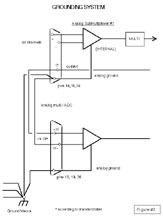Description:
The data acquisition system (DAS) was designed to interface any experiment with up to 240 different analog or digital outputs to a computer. The DAS is a modular form built into single width NIM modules and a typical system is composed from five basic modules. One control module, one 16 input Analog Multiplexer / ADC, 16 input Analog Submultiplexers as required, Dual 16 bit Digital Word modules as required, and a serial to RS232 module if required.| Module Control Analog Multiplexer/ADC Analog Submultiplexer Dual Digital Word Serial/RS232 |
mA @ +15V 35 45 35 5 100 |
mA @ -15V 0 35 25 0 0 |
 *Bi-phase data stream
*Bi-phase data stream Figure 3
or smaller
postscript file
shows a suitable analog ground arrangement.
Figure 3
or smaller
postscript file
shows a suitable analog ground arrangement.